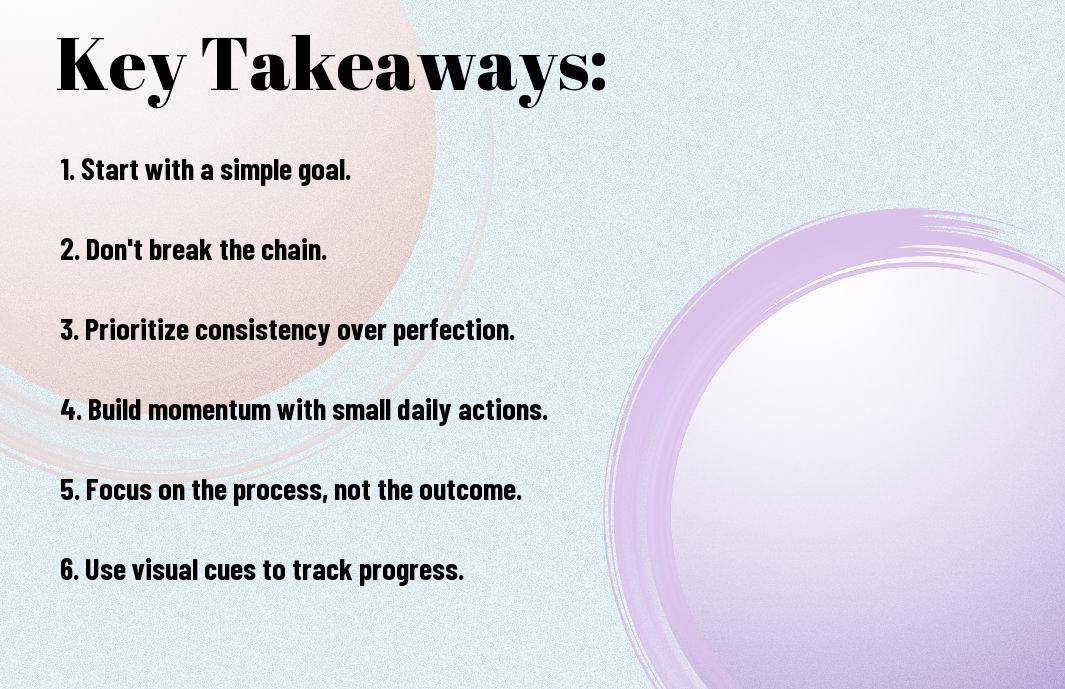
Newsletter Subscribe
Enter your email address below and subscribe to our newsletter

Enter your email address below and subscribe to our newsletter

Seinfeld Strategy! Most people are familiar with Jerry Seinfeld as a legendary comedian, but what many may not know is the powerful strategy he used to achieve success – the Seinfeld Strategy. This method, attributed to Jerry Seinfeld, focuses on maintaining consistency and building habits to reach goals effectively. By understanding and implementing this strategy, individuals can make significant progress towards their objectives in a structured and sustainable manner.


Some may know Jerry Seinfeld as a legendary stand-up comedian, actor, and co-creator of the iconic sitcom “Seinfeld”. But what many may not realize is that he is also the inspiration behind a powerful productivity strategy known as the Seinfeld Strategy.
Origins of the Seinfeld Strategy can be traced back to an anecdote about the comedian himself. As the story goes, a young aspiring comedian once approached Seinfeld and asked for advice on how to become a better comic. Seinfeld’s response was simple yet profound – “Don’t break the chain.”
Some believe that this anecdote was the inception of what we now know as the Seinfeld Strategy – a method for maintaining consistency and building habits through the simple act of daily action.

Days where you do not make any progress towards your goals can be detrimental to your success. The concept of non-zero days emphasizes the importance of doing at least one thing each day, no matter how small, that contributes to your long-term objectives. By focusing on avoiding zero days, you cultivate a habit of consistency and momentum that propels you forward.
Days
Adopting a chain-building mentality involves viewing each day as a link in a larger chain of progress. The idea is to not break the chain by missing a day of working towards your goals. This mentality encourages you to stay committed and disciplined, fostering a sense of accomplishment with each added link.
With a chain-building mentality, you shift your focus from individual tasks to the overarching progress you are making over time. This shift in perspective helps you stay motivated and dedicated to your goals, even when faced with challenges or setbacks.
Progress
Visual progress tracking involves physically marking or recording your daily accomplishments to visualize your consistency and growth. This visual representation serves as a tangible reminder of your dedication and the effort you have put in each day. By seeing your progress accumulate over time, you reinforce the habit of consistency and boost your motivation to continue.
Visual progress tracking can be as simple as crossing off tasks on a calendar or using a habit-tracking app to monitor your daily efforts. The act of visually seeing your chain of accomplishments grow instills a sense of satisfaction and fulfillment, pushing you to maintain your streak and further solidify your habits.
Once again, the first step in implementing the Seinfeld Strategy is choosing a specific activity or goal that you want to work on consistently. It’s important to select something that is meaningful to you and aligns with your long-term objectives. Whether it’s exercising daily, writing a page of a book, or practicing a new skill, make sure it’s something that you can realistically commit to on a regular basis.
With the chosen activity or goal in mind, the next step is to establish a tracking system to monitor your progress. This could be a simple calendar, a habit-tracking app, or a journal where you mark off each day that you successfully engage in the desired behavior. Setting up a visual representation of your consistency will help you stay motivated and accountable.
Strategy: Consider placing your tracking system in a prominent location where you will see it every day, such as on your refrigerator or bedside table. This constant visual reminder will reinforce your commitment to the goal and make it easier to track your daily progress.
On a daily basis, make a conscious effort to prioritize the activity or goal you’ve chosen to focus on. Consistent daily execution is key to building a lasting habit. Strive for excellence in your performance, even on days when motivation is low. Be mindful of, it’s the consistency that will ultimately lead to success.
This requires discipline and commitment, but with practice, it will become easier over time. Create a routine around your chosen activity to help streamline the process and make it a seamless part of your daily life.
Choosing to pursue a goal or activity consistently doesn’t mean you won’t face interruptions or setbacks along the way. For instance, unexpected events, fatigue, or lack of motivation can derail your progress. It’s important to anticipate these challenges and have a plan in place to overcome them.
All successful habits are reinforced by a reward system that encourages repetition. When we consistently engage in a behavior and receive positive feedback or a sense of accomplishment, our brain associates that action with a reward. This reinforcement mechanism strengthens the neural pathways associated with the habit, making it more likely for us to repeat the behavior in the future. Consistency is key in ensuring that the reward system is activated each time the desired behavior is performed, leading to the establishment of a habit.
With each repeated action, momentum builds towards solidifying a habit. Consistent repetition of a behavior creates a sense of familiarity and ease, making it easier for the mind to default to that action. As momentum grows, the effort required to maintain the habit decreases, and the behavior becomes more automatic. Consistency and persistence in the initial stages are crucial for overcoming resistance and establishing momentum in habit formation.
Habit formation is a gradual process that requires patience and dedication. It is vital to start small and gradually increase the complexity of the habit to prevent overwhelm and maintain momentum.
Psychology plays a crucial role in understanding and overcoming the resistance to change when attempting to establish new habits. Familiarity and comfort with existing routines can create resistance to adopting new behaviors, even if they are beneficial. By recognizing and addressing the psychological barriers to change, individuals can navigate through discomfort and uncertainty to embrace new habits that align with their goals and values.
Developing self-awareness and understanding the underlying beliefs and fears that fuel resistance can empower individuals to challenge and reframe their mindset towards change.
Mobile apps and digital tracking tools have revolutionized the way individuals can implement the Seinfeld Strategy in their daily routines. These tools allow users to easily track their progress, set reminders, and receive notifications to keep them on track. Apps like HabitBull, Streaks, and Good Habits provide a digital platform for individuals to visually see their progress and stay motivated.
For those looking to enhance their productivity even further, integrating the Seinfeld Strategy with other productivity methods can be highly effective. By combining this strategy with techniques like the Pomodoro Technique or Getting Things Done, individuals can create a comprehensive system that addresses both habit-building and task management. This integration allows for a more holistic approach to productivity and goal achievement.
Plus, by incorporating the Seinfeld Strategy with other productivity methods, individuals can leverage the strengths of each technique to create a personalized system that suits their unique needs and goals.
One of the key benefits of the Seinfeld Strategy is its flexibility, allowing individuals to tailor the approach to their personal preferences. This can include adjusting the length of the chain, choosing different types of habits to track, or incorporating rewards for meeting milestones. Any modifications made should align with the individual’s goals and motivations to ensure long-term success.
Personal preferences and lifestyle factors play a crucial role in the effectiveness of the Seinfeld Strategy. By customizing the approach to fit individual needs, individuals can create a sustainable habit-building system that works best for them.

Many individuals have experienced profound benefits from implementing the Seinfeld Strategy in their daily lives. By focusing on consistency and building habits, people have been able to make significant progress towards their goals and aspirations. The simple act of not breaking the chain of daily tasks or actions has proven to be a powerful motivator for staying on track and maintaining momentum. This strategy has helped individuals from all walks of life, whether they are working towards personal development, professional success, or health and fitness goals.
Success: Countless success stories and testimonials have emerged, highlighting the positive impact of the Seinfeld Strategy. Individuals have reported increased productivity, improved focus, and a heightened sense of accomplishment by following this method. By consistently showing up and making progress each day, people have experienced tangible results and a newfound sense of confidence in their abilities.
An: In the long term, implementing the Seinfeld Strategy can lead to a more structured and disciplined approach to achieving goals. By establishing daily routines and habits, individuals can create a solid foundation for success that extends far beyond the initial habit-building phase. Consistency breeds success, and by committing to the Seinfeld Strategy, people can sow the seeds for long-lasting productivity and achievement.
Another: While the Seinfeld Strategy has garnered praise for its effectiveness, it has also faced some critiques and counterpoints. Some argue that focusing too heavily on the chain method can lead to a narrow-minded approach to productivity, potentially overlooking the importance of flexibility and adaptability in goal-setting. Additionally, critics suggest that relying solely on the Seinfeld Strategy may not account for the complexities and nuances of individual goals and aspirations.
This: Despite these critiques, it is necessary to recognize that the Seinfeld Strategy is a tool that can be tailored to suit individual needs and preferences. By striking a balance between consistency and flexibility, individuals can harness the power of this method while also allowing room for personal growth and adaptation. It is important to approach the Seinfeld Strategy with a mindset of mindfulness and intentionality, leveraging its strengths while mitigating its potential limitations for a more holistic approach to achieving success.
Taking this into account, the Seinfeld Strategy has proven to be a powerful tool for maintaining consistency and building habits. By focusing on the process rather than the end goal, individuals can create a sense of accomplishment and momentum that propels them forward. By utilizing this method, individuals can develop positive habits that are sustainable and long-lasting.
For those looking to implement this strategy and build new habits, it is important to understand the psychology behind habit formation. With the right approach, anyone can cultivate habits that stick. To learn more about how to build new habits that stick, check out this comprehensive guide on How to Build New Habits That Stick [The Ultimate Guide].
A: The Seinfeld Strategy is a productivity technique attributed to Jerry Seinfeld, where he emphasized consistency in building habits by marking off calendar days for each completed task or goal.
A: The Seinfeld Strategy works by setting a specific goal, performing the task every day, and marking each day on a calendar once the task is completed. The visual chain of marks creates a sense of accomplishment and motivates continued consistency.
A: Consistency is crucial in building habits because repetition reinforces behavior, making it more automatic over time. Consistency helps to solidify new habits and maintain progress towards goals.
A: The Seinfeld Strategy can enhance productivity by encouraging daily action towards a goal, promoting accountability through visual tracking, and reinforcing the habit-building process through consistent effort.
A: Some key benefits of using the Seinfeld Strategy include increased motivation, improved consistency, better time management, enhanced focus on goals, and a sense of accomplishment from visual progress tracking.
A: To implement the Seinfeld Strategy effectively, one should start with a clear and achievable goal, create a visual tracking system like a calendar or app, commit to daily action, stay organized, and stay motivated by seeing the chain of progress grow.
A: Yes, the Seinfeld Strategy can be applied to different areas of life, such as fitness, work projects, learning new skills, breaking bad habits, or any other goal that requires consistency and habit formation.
The One Thing – Gary Keller and Jay Papasan’s Focus on Making Everything Else Easier
The 1-3-5 Rule – A Strategy to Balance Task Completion Across Complexity
Reduce Digital Distractions with Cal Newport’s Strategy- Digital Minimalism
Eisenhower Matrix – Dwight D. Eisenhower’s Strategy to Prioritize Tasks by Urgency and Importance
Study Routines Transformed: Unleash Atomic Habits for Students to Boost Your Studies